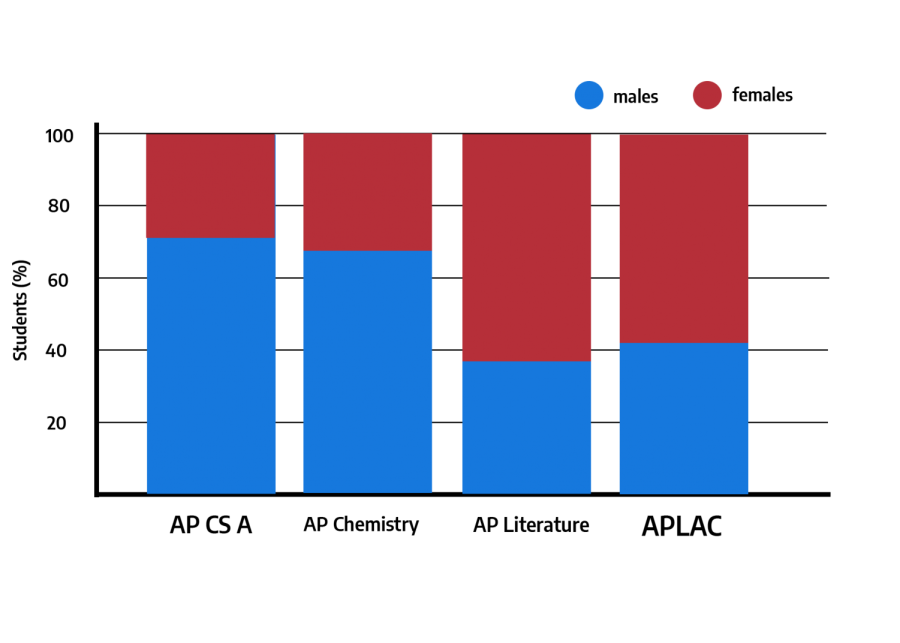Editorial: Gender disparities in AP courses influence classroom dynamics
Graphic illustration by Elizabeth Cheng
There are significant disparities between the number of male and female students present in certain classes, especially in AP-level STEM classes, which feature an average 3-2 ratio of boys to girls.
December 7, 2021
Although Lynbrook is widely viewed as an encouraging environment for students to pursue their aspirations regardless of sex, there are still significant disparities between the number of male and female students present in certain classes, especially in AP-level STEM classes, which feature an average 3-2 ratio of boys to girls. Students of different sexes are typically treated equitably in these classes, but the demographic disparity can make minority groups feel inferior and hesitant to fully engage in the content.
With women holding less than 30% of all STEM jobs in America, many companies are reevaluating their hiring processes, and educational institutions are pushing more women to pursue STEM majors and careers. These efforts to encourage more women to pursue STEM careers are even more effective when implemented early on, especially in schools.
To combat this, the Lynbrook community should continue working toward creating comfortable classroom environments for people of both sexes. Teachers and administrators should encourage students of the sex that traditionally make up a lesser portion of certain classes to sign up to take the course through outreach efforts to naturally motivate student interest.
Lynbrook prides itself on student enthusiasm surrounding its STEM courses such as AP Computer Science A, AP Chemistry and AP Physics C, which have consistently been a top request by students over the years. Yet when looking at the distribution of sex throughout classes, only a few advanced classes have a ratio of male and female students similar to that of the student body. For example, many STEM courses often have only several girls in a class full of boys. For example, in Thanh Nguyen’s 6th period AP Physics class, there are 19 boys but only nine girls. This is also a trend in other higher level science or math classes, such as AP Calculus BC and AP Chemistry, in which the ratio of male to female is often close to 2-to-1.
However, the ratio of girls to boys in AP humanities courses often tilts in the opposite direction. AP Language and Composition teacher Josh Miller’s 3rd and 4th period APLAC classes are 69% girls and 31% boys and 72% girls and 28% boys, respectively. AP Language and Composition teacher Dave Clark notes a similar disparity, citing an approximate 60% to 40% split between females and males. The overall ratio of all APLAC students, however, is 73% girls and 27% boys.
Despite the counselors’ best efforts, disparities remain. However, they are constantly working to equalize the number of girls and boys in classes. At the beginning of each year, if time permits, counselors go through every subject area of classes and examine the demographics. If they notice any large disparities, they will do their best to change students’ tentative schedules in order to reach close to a 1-1 ratio of sex while still providing an equal opportunity of classes to every student.
“We’re conscientious about gender disparities in terms of classroom dynamics, so we try to split girls and boys evenly in each class,” guidance counselor Nikki Dang said.
A degree of the disparities can be explained in part by the total difference between boys and girls in the school. The total student enrollment in the 2020-21 school year was 1922 — 52% were male and 48% were female. These numbers have stayed consistent over the years, so in general, there are slightly more males than females in any average class. However, the amount of interest in each course by gender also plays a substantial role.
“We assign students their classes based on what they signed up for,” Dang said. “If it’s a 5-1 ratio of males to females, [then] that’s what is reflected in class demographics.”
Since less girls are signing up for STEM classes, the disparity will persist. However, what discourages some girls from taking advanced STEM classes are classroom dynamics that promote the notion that girls are more successful in humanities courses.
“It is definitely more intimidating to speak up [in a male-dominated class] because it’s harder to identify a support system in your peers when you feel like you can’t easily relate to them,” said senior Jasmine Hou about her experience in AP STEM classes such as AP Computer Science Principles, AP Physics, AP Calculus BC, AP Biology and AP Statistics.
The solution to these disparities is more complex than just equalizing the number of male and female students in classes. To maintain an equal number of sign-ups for courses, Lynbrook and FUHSD should provide outreach and education opportunities to inform students and parents about the importance and interest in taking both STEM and humanities. However, it should be noted that Lynbrook is fairly progressive when it comes to promoting women in STEM and tends to be supportive of anyone looking to pursue STEM, mainly due to the larger emphasis placed on STEM in Silicon Valley.
“I can see there is a positive trend in classes like AP CS principles,” Computer Science teacher Mark Kwong said. “But there is still a lot of work to do to even out the rest of the CS classes.”
For example, before course selection is due, teachers from AP courses could create short videos explaining their courses, in an attempt to inform and pique student interest in an effective and efficient manner. This approach could also be taken on by the guidance counselors, who often already visit classrooms during course selection. In addition to their current presentation, they could help familiarize students with the content they would be learning in AP courses. Furthermore, in the second semester, teachers could explain the following year’s available courses to their class so students are fully informed when selecting courses.
Making students comfortable in the classroom environment in regards to gender interaction should be taken into consideration. Students can work on including all their peers when working in groups and communicating respectfully with everyone in class. Teachers have already taken on this task — for example, when there is an evident disparity, Kwong makes sure all girls in his AP CS classes are seated near another girl in order to make them feel supported.
“I try to seat girls together in class when there is a disparity, usually in my Java programming class,” Kwong said. “It’s probably daunting to walk into a class as the minority, so I try to help them feel more comfortable.”
Lynbrook’s students, teachers and administration have made consistent efforts to promote equality among the classes, clubs and other organizations on campus. However, students and teachers alike must continue to work toward inclusive classes so all students feel comfortable, respected and empowered on campus.
*the Epic staff voted 32-0 in favor of this stance, with 4 staff members abstaining.
For the sake of data comparison, this analysis of sex on campus is split into male and female, but the Epic recognizes the complexity of gender identities and those who identify as non-binary. If you’d like to be a part of this conversation, you are encouraged to submit a guest column or letter to the editors.



































































